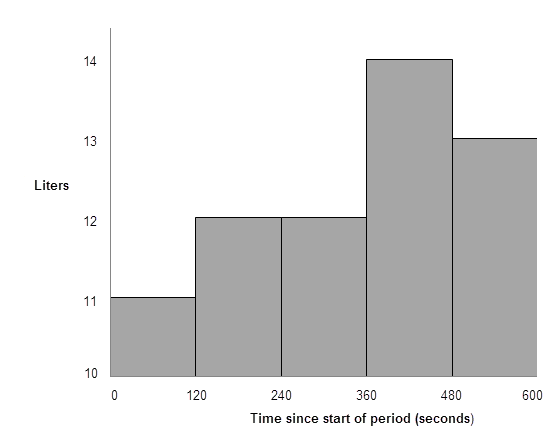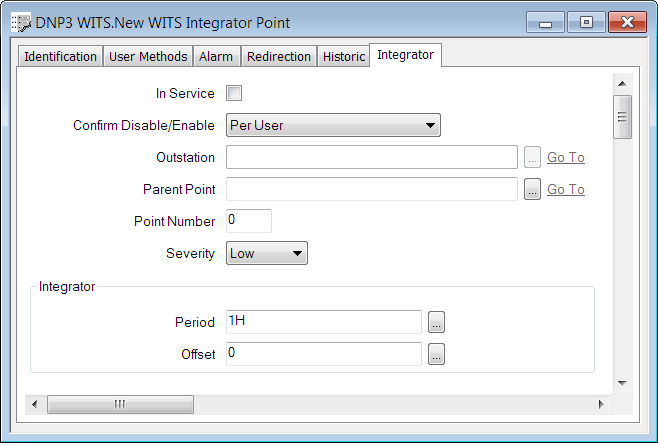In ClearSCADA, you use a WITS Integrator Point database item to represent an Integral point in a WITS Field Device. An Integral point is a virtual analog input point.
The Field Device calculates the integral value for a particular analog point, over a specific calculation period, and then stores the value in the Integrator point. The Integrator point is therefore a derived point - that is, it derives its value from the value of another analog point (the parent point) (see Derived Points in the ClearSCADA Guide to Core Point Configuration).
An integral is the sum of a series of analog values, that are multiplied by the elapsed time (in seconds) since the preceding value. The integral accumulates from the start of the calculation period. At the start of the next period, the device resets the integral to 0.
Example:
The following example shows how the Field Device would calculate an integral - in this case, the total volume of water that has flowed past a particular location in a 10 minute period.
The Integrator point's parent point measures the flow of water past the location in liters per second. The graph below shows the recorded values over the 10 minute calculation period:

The Field Device calculates the integral as follows:
(11 x 120) + (12 x 240) + (14 x 120) + (13 x 120) = 7440 liters in 10 minutes.
WITS Integrator Point database items have a combination of configuration properties that are:
- Common to many types of point
- Common to DNP3 points
- Specific to WITS Integrator points.
To configure a WITS Integrator Point database item, you use the WITS Integrator Point Form.

The Form contains many fields, organized into tabs. Some of these tabs are common to many types of database item (see Tabs on Point Forms in the ClearSCADA Guide to Advanced Drivers).
NOTE: This point is a type of analog point. Therefore, you can find information about the common functionality for this point in the Analog Points sections of the ClearSCADA Guide to Core Point Configuration. Some of the links below refer you to the relevant sections in that guide.
The Integrator tab contains properties that are specific to WITS. Use the fields on the tab to:
- Configure the point's General Properties (see General Point Properties - WITS Integrator Points)
- Specify the analog point (the parent point) for which the Field Device should calculate the integral value (see Specify a Parent Point )
- Specify the calculation period for the integral value (see Calculation Period for the Integral Value)
- Configure the point's Scanning State Properties (see Scanning States for WITS Database Points)
- Configure the point's Alarm Limits (see Alarm Limits for WITS Integrator Points)
- Configure any Alarm Limit Profiles (see Profiles for WITS Database Points)
- Configure the point's DNP3 Object Flag Options (see DNP3 Object Flag Actions)
- Configure the point's Formatting Properties (see Define the Appearance of an Analog Point's Values in the ClearSCADA Guide to Core Point Configuration)
- Configure the point's Multiplier value (see Configure the Multiplier Value in the ClearSCADA Guide to the DNP3 Driver)
- Configure the point's Override Properties (see Define whether an Analog Point can be Overridden in the ClearSCADA Guide to Core Point Configuration)
- Configure the point's Trend Properties (see Trend Settings for WITS Integrator Points)
- Configure the point's Logged Data Properties (see Logged Data for WITS Database Points)
- Configure the point's Historic Data Filter Properties (see Historic Data Filter for WITS Database Points).
When you have completed the point's configuration, you need to download the configuration to the Field Device by using the Outstation database item's Download Configuration (WITS Outstation) action. If your Field Device does not support configuration download, you will need to make the same changes to the Field Device's configuration locally.